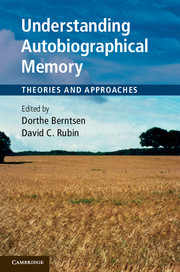Book contents
- Frontmatter
- Contents
- List of figures
- List of tables
- List of contributors
- Preface
- Acknowledgements
- 1 Introduction
- Part I Approaches to the study of autobiographical memory
- Part II Neural studies of autobiographical memory
- Part III Social and cultural aspects of autobiographical memory
- Part IV Development of autobiographical memory from infancy to old age
- Part V Evolution and basic processes of autobiographical memory
- Part VI Discussion
- Index
Part I - Approaches to the study of autobiographical memory
Published online by Cambridge University Press: 05 November 2012
- Frontmatter
- Contents
- List of figures
- List of tables
- List of contributors
- Preface
- Acknowledgements
- 1 Introduction
- Part I Approaches to the study of autobiographical memory
- Part II Neural studies of autobiographical memory
- Part III Social and cultural aspects of autobiographical memory
- Part IV Development of autobiographical memory from infancy to old age
- Part V Evolution and basic processes of autobiographical memory
- Part VI Discussion
- Index
Summary
Approaches to the study of autobiographical memory
How should studies on autobiographical memory be approached? The four chapters in this section address this question from different perspectives. The chapter by Rubin examines the neural and biological bases of autobiographical information. Rubin describes the construction of autobiographical memories as an interaction between functionally distinct subsystems of the mind and brain. He also discusses the implications of this view for our broader understanding of memory. The chapter by Habermas links modern research on autobiographical memory to the earlier psychoanalytic approach to the same phenomenon. Habermas offers a unique introduction to psychodynamic theories of autobiographical memory, and discusses the differences and similarities between these early approaches and modern ones.The chapter by Conway and Jobson addresses the role of the self, its goals, and its social and cultural context in the processing of autobiographical information and construction of memories. This chapter thus emphasizes the cultural, social, and motivational aspects of autobiographical remembering. The section ends with a chapter by Baddeley. As one of the early pioneers of autobiographical memory research, Baddeley takes a historical perspective and evaluates a number of different empirical approaches that have emerged over the years. He concludes by a call for more theoretical integration.
- Type
- Chapter
- Information
- Understanding Autobiographical MemoryTheories and Approaches, pp. 9 - 10Publisher: Cambridge University PressPrint publication year: 2012



